Dermatological Therapeutics Market Size and Share
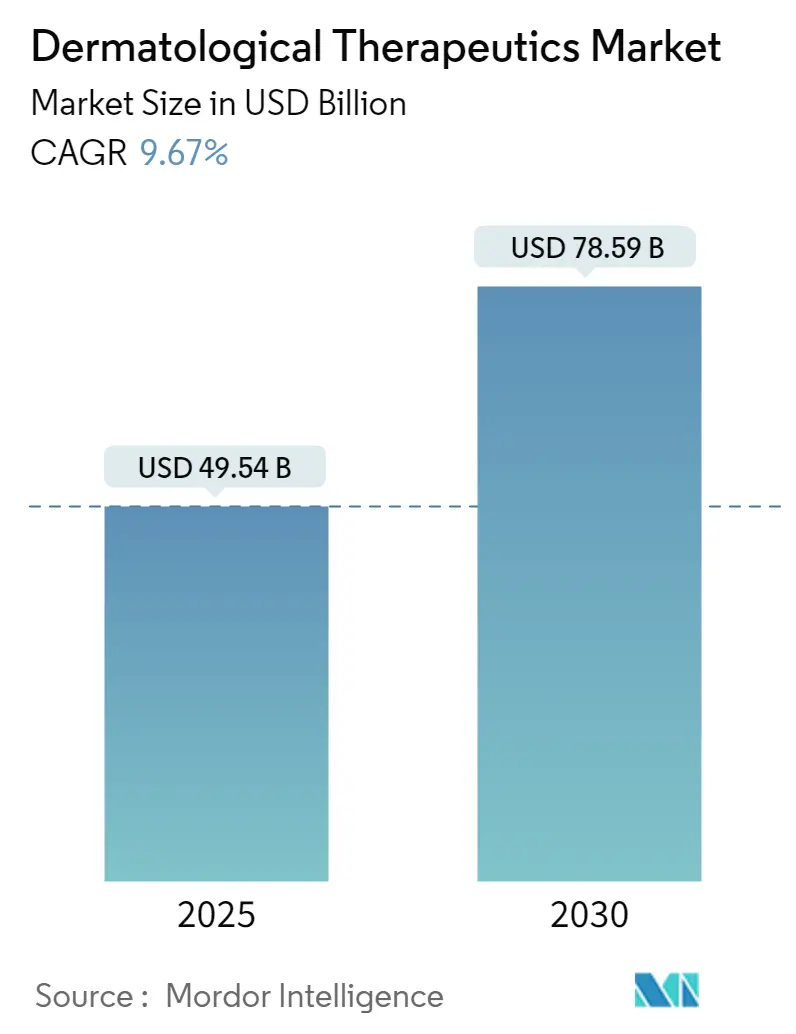
Dermatological Therapeutics Market Analysis by Mordor Intelligence
The dermatological therapeutics market size stands at USD 49.54 billion in 2025 and is forecast to reach USD 78.59 billion in 2030, expanding at a 9.67% CAGR across the period. This solid trajectory mirrors rapid biologic penetration, regulatory fast-tracking for orphan skin diseases, and the swift integration of tele-dermatology. Breakthrough therapy designations for alopecia areata and hidradenitis suppurativa shortened approval timelines, while China’s drug-approval overhaul opened Asia-Pacific to innovative molecules. At the same time, GLP-1-induced skin disorders are broadening therapeutic demand, and digital pharmacies are resolving specialist bottlenecks. Competitive pressure is intensifying as patent cliffs invite biosimilar rivals and push incumbents to refresh portfolios through acquisitions and next-generation platforms.
Key Report Takeways
By drug class, biologics led with 38.34% of dermatological therapeutics market share in 2024; small-molecule rivals helped the same class clock an 11.01% CAGR through 2030.
By disease, psoriasis accounted for 32.48% share of the dermatological therapeutics market size in 2024 and hidradenitis suppurativa is expanding at a 9.81% CAGR to 2030.
By route of administration, topical formulations captured 51.57% share of the dermatological therapeutics market size in 2024 and injectables are advancing at a 10.03% CAGR through 2030.
By distribution channel, retail pharmacies commanded 43.82% share of the dermatological therapeutics market in 2024, whereas online pharmacies are forecast to rise at a 10.19% CAGR to 2030.
By geography, North America held 38.21% share of the dermatological therapeutics market in 2024, while Asia-Pacific is on course for a 10.78% CAGR to 2030.
Global Dermatological Therapeutics Market Trends and Insights
Driver Impact Analysis
| Driver | (~) % Impact on CAGR Forecast | Geographic Relevance | Impact Timeline |
|---|---|---|---|
| Rising prevalence of chronic dermatological diseases | +2.1% | Global developed markets | Long term (≥ 4 years) |
| Rapid uptake of biologics & targeted therapies | +2.8% | North America, EU, APAC | Medium term (2–4 years) |
| Growing aesthetic consciousness and disposable income | +1.6% | North America, EU, urban APAC | Medium term (2–4 years) |
| Technological advances in topical & transdermal delivery | +1.4% | Global R&D hubs | Long term (≥ 4 years) |
| Regulatory fast-tracking for orphan indications | +0.9% | U.S., EU | Short term (≤ 2 years) |
| GLP-1 weight-loss boom driving skin-repair demand | +0.8% | North America, EU, affluent APAC | Short term (≤ 2 years) |
| Source: Mordor Intelligence | |||
Rising Prevalence of Chronic Dermatological Diseases
Psoriasis now affects 0.33%–0.6% of the global population, while atopic dermatitis spans up to 20% of children, elevating systemic inflammation concerns and driving longer treatment tenures. Real-world epidemiology is converting what was once deemed cosmetic into chronic, immune-mediated pathology. That shift legitimizes premium pricing for targeted therapies and expands prescribing beyond dermatologists to primary-care physicians. Health payers are increasingly ranking moderate-to-severe skin disease management with diabetes and arthritis, further anchoring the long-range outlook for the dermatological therapeutics market.
Rapid Uptake of Biologics & Targeted Therapies
Dupilumab’s performance in bullous pemphigoid trials and rocatinlimab’s ROCKET data underscore the superior remission depth achievable when cytokine pathways are selectively blocked. JAK inhibition has moved past rheumatology, with povorcitinib entering Phase 3 for vitiligo. Broader payer coverage—DUPIXENT reaches 99% in the U.S.—lowers entry barriers, yet prior-authorization drag still slows starts and burdens staff. Even so, expedited FDA reviews keep pipeline velocity high, ensuring the dermatological therapeutics market continues pivoting toward biologic-centric regimens.
Growing Aesthetic Consciousness and Disposable Income
Social-media filters and virtual meetings sustain vigilance about skin appearance, prompting demand for cross-over solutions that alleviate disease and enhance looks. Galderma’s RelabotulinumtoxinA posted 92% month-one satisfaction in trials, confirming readiness to pay for durable cosmetic benefits. Clinics now bundle acne, rosacea, and anti-aging plans, raising ticket sizes. Programs like Allergan’s AA Signature demonstrate that holistic consultation doubles retention, turning aesthetic users into lifelong therapeutic clients.
Technological Advances in Topical & Transdermal Delivery
Nanocarriers such as transethosomes break the 500-Dalton ceiling, ferrying peptides deep into the dermis without systemic spillover. AI-guided formulation now calibrates viscosity and pH before dosing first-in-human studies, quickening development. Wearable patches that sense skin impedance can auto-modulate release, improving adherence and cutting clinic visits—an important lever where physician density is falling. These breakthroughs raise the ceiling for non-invasive care and broaden the addressable pool for the dermatological therapeutics market.
Restraint Impact Analysis
| Restraint | (~) % Impact on CAGR Forecast | Geographic Relevance | Impact Timeline |
|---|---|---|---|
| High cost & reimbursement hurdles for biologics | -1.8% | Global, particularly in emerging markets with limited insurance coverage | Medium term (2-4 years) |
| Patent cliffs & biosimilar erosion | -1.2% | Developed markets with established biosimilar regulatory pathways | Short term (≤ 2 years) |
| Dermatologist shortages in emerging economies | -0.9% | APAC, Latin America, Middle East & Africa rural regions | Long term (≥ 4 years) |
| Proliferation of counterfeit online dermatology drugs | -0.6% | Global, with higher concentration in unregulated online marketplaces | Medium term (2-4 years) |
| Source: Mordor Intelligence | |||
High Cost & Reimbursement Hurdles for Biologics
Medicare’s 2025 conversion-factor reduction of 2.83% compresses clinic margins, deterring first-line biologic use even in severe cases. Prior-authorization queues prolong symptom flares, harming outcomes and patient satisfaction. Annual therapy costs above USD 50,000 exceed many benefit caps; assistance programs fill gaps but exclude portions of uninsured groups. Disparate coverage undermines equity, especially in markets pivoting to value-based reimbursement that demands real-world evidence before greenlighting spend.
Patent Cliffs & Biosimilar Erosion
Humira’s revenue halved to USD 1.12 billion post-LOE, validating how 20%–30% price discounts lure prescribers once substitution becomes permissible. Stelara and Tremfya face similar risk inside the forecast horizon, pressuring innovators to race fresh indications to market. Streamlined EMA and FDA biosimilar tracks shorten rival entry, forcing heavier R&D investment in next-gen assets or risk multi-billion-dollar free-fall.
Segment Analysis
By Disease: Psoriasis Dominance Faces Rare-Disease Innovation
Psoriasis supplied 32.48% of dermatological therapeutics market share in 2024, benefiting from guideline-endorsed early biologic use and multiple IL-17/IL-23 options. Hidradenitis suppurativa is pacing a 9.81% CAGR on the back of greater diagnostic awareness and new immune targets. Atopic dermatitis remains a revenue pillar, fortified by nemolizumab’s imminent U.S. and EU launch approvals. Alopecia areata surged after deuruxolitinib gave severe cases the first oral solution.
Other segments such as acne vulgaris and seborrheic dermatitis expand steadily through combination regimens that improve compliance. Rosacea R&D pivots toward anti-inflammatory pathways beyond antibiotics. The Others bucket—vitiligo, bullous pemphigoid—shows pipeline density after povorcitinib and dupilumab hit Phase 3 marks. Accelerated regulatory programs for orphan conditions are shortening time-to-market, magnifying rare-disease share in the dermatological therapeutics market.
Psoriasis keeps leadership because life-cycle management adds long-acting injections and child indications, yet rare diseases grow faster percentage-wise. Clinicians foresee blended portfolios where blockbuster immune modulators finance niche-indication pursuits. Thus revenue concentration gradually diffuses across a broader disease mix while retaining psoriasis primacy in the dermatological therapeutics market.
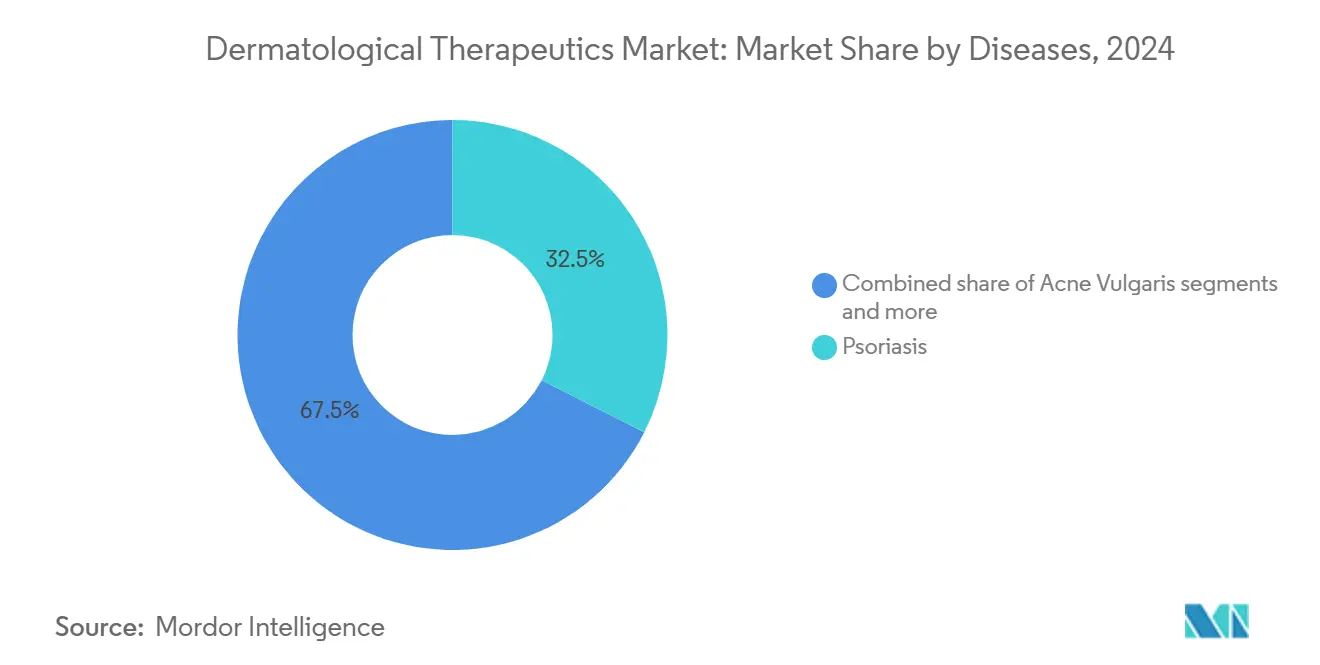
By Drug Class: Biologics Sustain Innovation Leadership
Biologics held 38.34% of the dermatological therapeutics market in 2024 and log the quickest 11.01% CAGR as next-generation antibodies target IL-17F and TYK2. JAK inhibitors anchor the small-molecule class with multi-organ potential; Rinvoq added giant cell arteritis to its list, proving label versatility. Topical corticosteroids keep first-line status, but safety-tuned micro-dosing eases long-term worries.
Retinoids gain bounce from nano-liposomal wraps that cut irritation. Anti-infectives shift toward combination formulations countering antimicrobial resistance. Calcineurin inhibitors preserve niche use on sensitive skin regions. PDE-4 and other emergent mechanisms sit in the Others column, with several Phase 2 readouts expected by 2026. The dermatological therapeutics market size tied to biologics expands as new modes such as bispecific antibodies and sub-cutaneous auto-injectors aim at better convenience. Biosimilars will erode mature biologic revenue, but price drops could expand total treated volume, partly offsetting top-line declines and keeping biologics the largest contributor within the dermatological therapeutics market.
By Route of Administration: Injectable Growth Outpaces Traditional Topicals
Topicals collected 51.57% of dermatological therapeutics market size in 2024, supported by OTC familiarity and localized safety. Injectables ride a 10.03% CAGR wave because chronic inflammation often needs systemic reach. Long-acting formulations trim visits to quarterly, promoting adherence. Oral small molecules offer daily convenience but suffer discontinuation spikes when side effects arise.
Transdermal patches are emerging, marrying microneedle arrays with nano-carriers to ferry peptides beyond the stratum corneum. Early implants under trial for vitiligo promise year-long steady dosing. The injectable surge is constrained by cold-chain demands and provider training, especially in low-resource settings. Yet payer evidence of superior disease control fuels systemic therapy adoption, expanding injectable share in the dermatological therapeutics market.
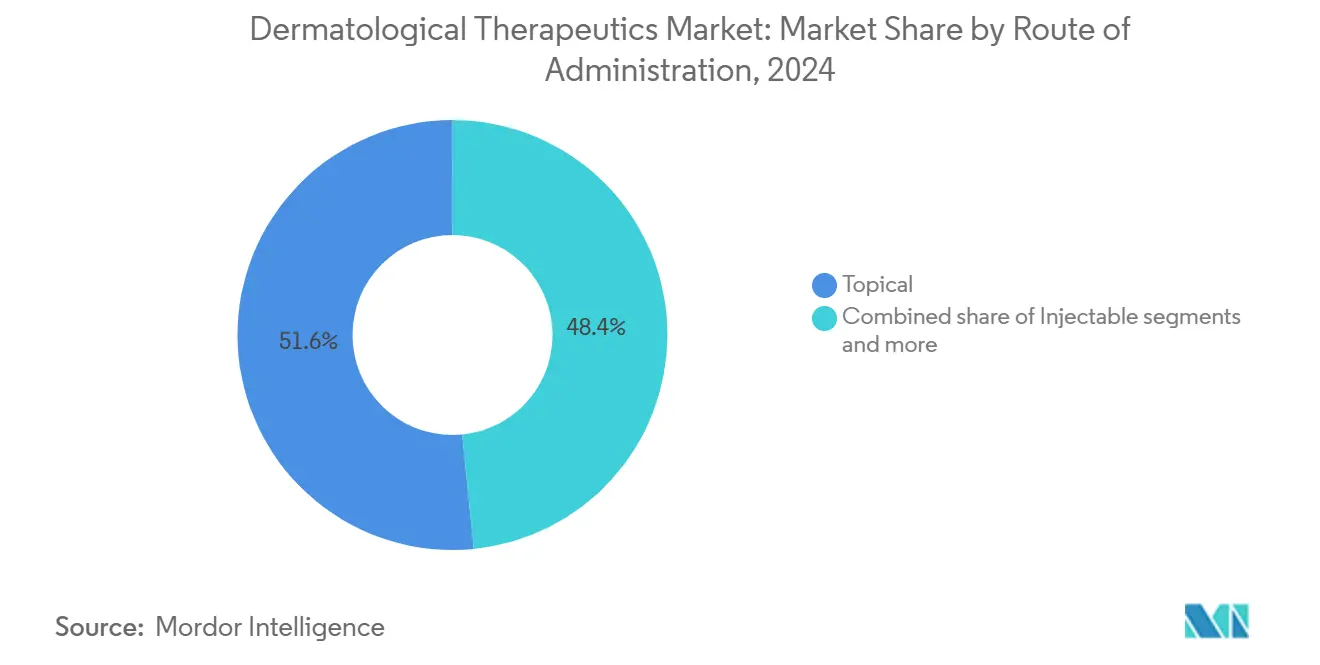
Note: Segment shares of all individual segments available upon report purchase
By Distribution Channel: Digital Transformation Accelerates Online Growth
Retail pharmacies led with 43.82% of the dermatological therapeutics market in 2024, leveraging insurance billing familiarity. Online pharmacies are registering a 10.19% CAGR as tele-dermatology integration routes e-prescriptions directly to fulfillment centers. Hospital pharmacies retain relevance for infusion-based biologics and acute flares requiring inpatient care.
AI triage tools now cut appointment waits from weeks to days, funneling new scripts into digital storefronts. Operation Pangea XVII seizures worth USD 65 million highlighted counterfeit risk, prompting blockchain tracking on high-value biologics. Improved verification builds trust, unlocking broader e-commerce adoption and scaling the end-to-end reach of the dermatological therapeutics market.Clinics combine therapeutic and aesthetic offerings, giving them premium margins but smaller volume. Still, omnichannel models that link clinic diagnostics with online refill reminders look set to dominate patient-journey mapping through 2030.
Geography Analysis
North America held 38.21% of dermatological therapeutics market share in 2024, energized by early biologic launches and broad insurance coverage, yet faced Medicare reimbursement cuts and prior-authorization hurdles. Dermatologist density dropped from 356 to 281 per 100,000 between 2013 and 2019, elevating AI diagnostic reliance. Digital assistance programs and broad co-pay cards keep biologic initiation steady. Social-media-driven cosmetic demand offsets reimbursement headwinds, anchoring North America atop the dermatological therapeutics market.
Asia-Pacific is the growth pacesetter with a 10.78% CAGR to 2030, buoyed by China’s 228 drug approvals in 2024 and pending regulatory alignment through 2027. Rising urban incomes unlock premium biologic demand, and countries like Japan and South Korea lead tele-health penetration, mitigating dermatologist shortages. India’s manufacturing prowess attracts biosimilar investment, while Australia’s EU-aligned fast-track reviews speed rare-disease drug entry. Collectively these dynamics lift Asia-Pacific’s weight within the dermatological therapeutics market.
Europe posts balanced expansion thanks to mature biosimilar frameworks lowering biologic costs without sacrificing access. Germany finances deep dermatology R&D, and post-Brexit UK fast-track systems aim to mimic FDA agility. France and Italy integrate real-world data into HTA decisions, pushing firms to invest in outcomes research. Sustainability regulations push green manufacturing, raising compliance costs but sharpening ESG profiles. Cross-border aesthetic tourism and an aging population further shore up Europe’s slice of the dermatological therapeutics market.
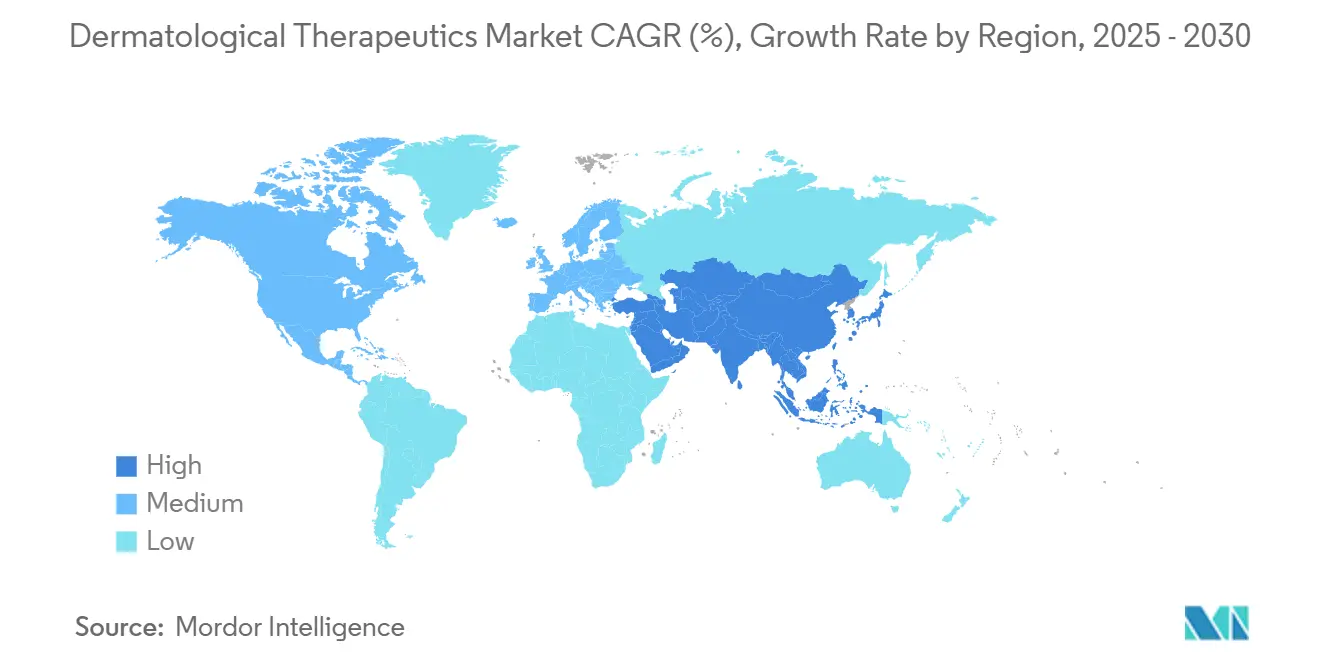
Competitive Landscape
The dermatological therapeutics market shows moderate concentration. AbbVie’s Q1 2025 immunology revenue hit USD 6.264 billion, with Skyrizi and Rinvoq achieving USD 5.1 billion combined on 65% growth[1]Source: AbbVie, “AbbVie Reports First-Quarter 2025 Financial Results,” abbvie.com . J&J spent USD 850 million on Proteologix, while LEO Pharma committed USD 105 million to collaborate with Boehringer on rare-skin compounds[2]Source: Galderma, “IMCAS 2025 Phase IIIb Data,” galderma.com . Crown-Revance merged, knitting neuromodulator expertise with novel delivery platforms.
Patent cliffs prompt defensive R&D, exemplified by AbbVie’s BLA for trenibotulinumtoxinE to diversify post-Humira. Biosimilars slash legacy biologic revenue yet widen treatment availability, fostering volume compensation. AI tools for diagnosis and adherence tracking are now strategic differentiators, allowing firms to tether companion apps to drug franchises.
Regulatory complexity and ESG compliance push smaller players toward licensing deals with big pharma. Venture-backed biotech focuses on orphan indications that enjoy high margins and accelerated review. Consequently, the dermatological therapeutics market preserves healthy rivalry while leaning on a handful of dominant actors for blockbuster launches.
Dermatological Therapeutics Industry Leaders
-
Amgen Inc.
-
Bausch Health Companies Inc.
-
Novartis AG
-
AbbVie Inc.
-
Almirall SA
- *Disclaimer: Major Players sorted in no particular order
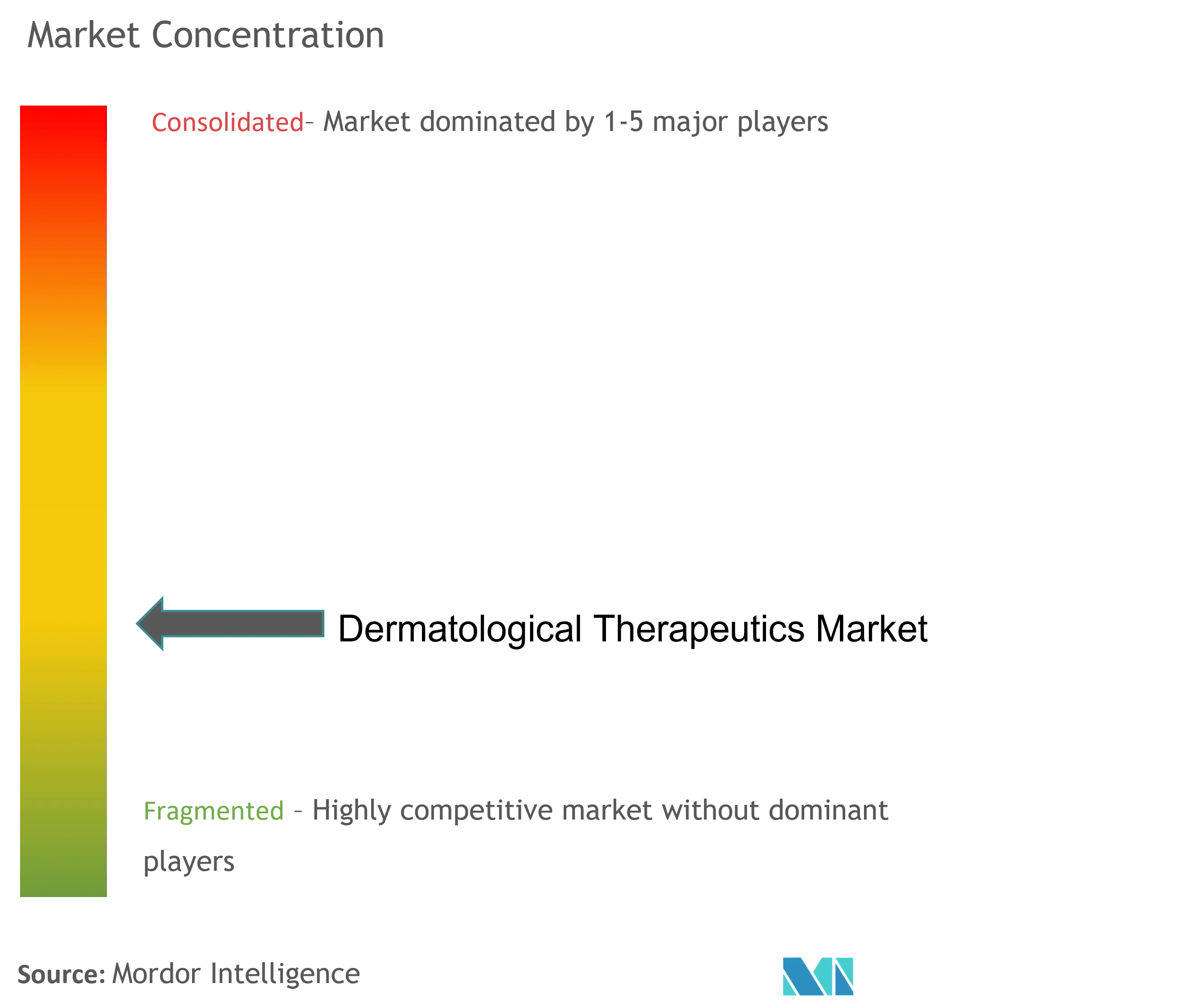


Recent Industry Developments
- January 2025: Galderma’s Phase IIIb RELAX trial showed 92% patient satisfaction at month 1 for RelabotulinumtoxinA; authorization secured in 14 EU states, Australia, UK
- June 2024: J&J closed USD 850 million Proteologix acquisition, strengthening dermatology pipeline.
Global Dermatological Therapeutics Market Report Scope
As per the scope of the report, dermatological therapeutics are drugs used to treat and prevent various dermatological conditions. The dermatological therapeutics market is segmented by application, drug class, and geography. By application, the market is segmented into alopecia, herpes, psoriasis, rosacea, atopic dermatitis, and other applications. By drug class, the market is segmented into anti-infectives, corticosteroids, anti-acne, calcineurin inhibitors, retinoids, and other drug classes. By geography, the market is segmented into North America, Europe, Asia-Pacific, the Middle East and Africa, and South America. The report also covers the estimated market sizes and trends for 17 countries across major regions globally. The report offers the market sizes and forecasts in terms of value (USD) for the above segments.
| Acne Vulgaris |
| Psoriasis |
| Atopic Dermatitis / Eczema |
| Alopecia Areata |
| Hidradenitis Suppurativa |
| Seborrheic Dermatitis |
| Rosacea |
| Others |
| Topical Corticosteroids |
| Retinoids |
| Anti-infectives (Antibiotics & Antifungals) |
| Calcineurin Inhibitors |
| Biologics & Biosimilars |
| Small-molecule Inhibitors (PDE-4, JAK, TYK2) |
| Others |
| Topical |
| Oral |
| Injectable |
| Transdermal Patches |
| Others |
| Hospital Pharmacies |
| Retail Pharmacies & Drugstores |
| Dermatology & Aesthetic Clinics |
| Online Pharmacies |
| North America | United States |
| Canada | |
| Mexico | |
| Europe | Germany |
| United Kingdom | |
| France | |
| Italy | |
| Spain | |
| Rest of Europe | |
| Asia-Pacific | China |
| India | |
| Japan | |
| South Korea | |
| Australia | |
| Rest of Asia-Pacific | |
| South America | Brazil |
| Argentina | |
| Rest of South America | |
| Middle East and Africa | GCC |
| South Africa | |
| Rest of Middle East and Africa |
| By Disease | Acne Vulgaris | |
| Psoriasis | ||
| Atopic Dermatitis / Eczema | ||
| Alopecia Areata | ||
| Hidradenitis Suppurativa | ||
| Seborrheic Dermatitis | ||
| Rosacea | ||
| Others | ||
| By Drug Class | Topical Corticosteroids | |
| Retinoids | ||
| Anti-infectives (Antibiotics & Antifungals) | ||
| Calcineurin Inhibitors | ||
| Biologics & Biosimilars | ||
| Small-molecule Inhibitors (PDE-4, JAK, TYK2) | ||
| Others | ||
| By Route of Administration | Topical | |
| Oral | ||
| Injectable | ||
| Transdermal Patches | ||
| Others | ||
| By Distribution Channel | Hospital Pharmacies | |
| Retail Pharmacies & Drugstores | ||
| Dermatology & Aesthetic Clinics | ||
| Online Pharmacies | ||
| By Geography | North America | United States |
| Canada | ||
| Mexico | ||
| Europe | Germany | |
| United Kingdom | ||
| France | ||
| Italy | ||
| Spain | ||
| Rest of Europe | ||
| Asia-Pacific | China | |
| India | ||
| Japan | ||
| South Korea | ||
| Australia | ||
| Rest of Asia-Pacific | ||
| South America | Brazil | |
| Argentina | ||
| Rest of South America | ||
| Middle East and Africa | GCC | |
| South Africa | ||
| Rest of Middle East and Africa | ||


Key Questions Answered in the Report
How fast is the dermatological therapeutics market growing to 2030?
The market is projected to climb from USD 49.54 billion in 2025 to USD 78.59 billion in 2030, reflecting a 9.67% CAGR.
Which therapy class leads sales?
Biologics held 38.34% revenue in 2024 and also record the quickest 11.01% CAGR, driven by IL-17 and JAK pathway innovation.
Which region will post the highest growth rate?
Asia-Pacific is forecast to lead with a 10.78% CAGR, helped by China's pro-innovation drug-approval reforms.
What is the biggest hurdle to biologic adoption?
High annual costs above USD 50,000 and complex prior-authorization hurdles slow uptake, especially in emerging economies.
How are biosimilars influencing competition?
Patent expiries on flagships like Humira invite biosimilars priced 20%-30% lower, cutting originator revenue almost by half within a year.
Will online pharmacies disrupt traditional channels?
Yes. Online platforms are expanding at a 10.19% CAGR because e-prescribing and tele-dermatology streamline access and bolster adherence.
Page last updated on:








